- Lifting- and Handlingtechnology
Getting the curve
Tough conditions for cleanroom lifting gear from Altmann
At the UCB pharmaceutical company near Brussels, a cleanroom hoist was needed to transport heavy loads. However, space was tight and the construction project was already at an advanced stage. Specialist Altmann overcame the difficulties and found a solution that could also be helpful elsewhere.
Car drivers as well as owners of Carrera racetracks know the problem: If you drive into a curve too fast, the tires squeal and you possibly fly out. If, on the other hand, the curve radius is too tight, you get stuck. Both rules of physics also apply to the transport of loads by hoist in the cleanroom under heavy conditions.
In the course of the complete crane installation of the extension building at the Belgian biopharmaceutical group UCB, it became clear in the fall of 2021 that a belt hoist with a curve radius would be needed for one of the cleanrooms. However, since other planning was already advanced and space was limited, Altmann, a supplier specializing in cleanroom crane systems, was faced with a r ather complex requirements profile. But it was precisely this that appealed to the professionals from Albaching in Bavaria and awakened their sporting ambition.
Special solution with exemplary character
The result of the "tinkering" produced a solution that impresses with its key data and could well be of interest to other industries and applications. Here, a standard belt hoist was adapted as a curved trolley in such a way that a load of 500 kg can be transported at a curve radius of only 1 meter at a s peed of 1.5 to 20 meters per minute, continuously adjustable by means of a frequency converter. And it does so virtually abrasion free in an ISO Class 6 cleanroom or in accordance with ISO 14644 1, where a maximum of 1,000 measurable particles per cubic fo ot may occur (which is even undercut here).
Company co owner Robert Altmann, who was responsible for the project, describes the challenge of the curvaceous energy supply, i.e., accommodating all the supply lines, as particularly "fun" because "after all we couldn't just bend them around the corner." Nevertheless, despite minimal radii, his team managed to neatly tuck everything away while still maintaining the speeds usual for much larger radii. "We can proudly claim that we have made optimum use of the available space
here while offering maximum performance," says Robert Altmann. The line was already installed at the end of March and is fully functional.
Innovative at a high level
Word has already spread in the industry about the technical sophistication of Altmann cranes. The Albaching based company cannot exactly complain about a lack of orders. Above all, the flat headroom of the cleanroom cranes makes it possible to make optimum use of the respective room height. In addition, compliance with ISO 14 6441 is not only ensured for the Altmann cleanroom cranes themselves, but particle contamination is also virtually ruled out during proper operation as well as during cleaning and maintenance work and also when retrofitting components or functions.
This is achieved by the fact that Altmann cranes are powder coated throughout and thus have smooth, scratch resistant and easy to clean surfaces. All cables, interlocking assemblies, glands, electrical components, sensors, and the hoist with electric belt pull are neatly "packaged" in enclosures. The materials are selected and combined in such a way that abrasion and outgassing are avoided as far as possible. The duplex load belts are absolutely maintenance free, hardly wear out and stretch only minimally due to a special material pairing. Conventional textile belts, on the other hand, first expand measurably in length before the load is even lifted. To avoid abrasion on the rotating load hook, it is either made of stainless steel in accordance with DIN 15400 or supplied with a resistant and robust coating.
Even if it will still take a little time until the final acceptance of the curved track at UCB in Brussels due to the size of the overall project, it can already be said today that a further benchmark has been set here. It is possible that other industries will soon also be "getting the hang on it" with heavy loads in the cleanroom.
![]()
ALTMANN GmbH
Oberdieberg 23-25
83544 Albaching
Germany
Phone: +49 8076 88790
email: info@altmann-foerdertechnik.de
Internet: http://www.altmann-foerdertechnik.de










